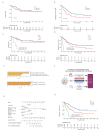Predictive value of pre-treatment circulating tumor DNA genomic landscape in patients with relapsed/refractory multiple myeloma undergoing anti-BCMA CAR-T therapy: Insights from tumor cells and T cells
- PMID: 39501801
- PMCID: PMC12487937
- DOI: 10.1097/CM9.0000000000003306
Predictive value of pre-treatment circulating tumor DNA genomic landscape in patients with relapsed/refractory multiple myeloma undergoing anti-BCMA CAR-T therapy: Insights from tumor cells and T cells
Abstract
Background: B-cell maturation antigen (BCMA)-directed chimeric antigen receptor T (CAR-T) therapy yield remarkable responses in patients with relapsed/refractory multiple myeloma (R/RMM). Circulating tumor DNA (ctDNA) reportedly exhibits distinct advantages in addressing the challenges posed by tumor heterogeneity in the distribution and genetic variations in R/RMM.
Methods: Herein, the ctDNA of 108 peripheral blood plasma samples from patients with R/RMM was thoroughly investigated before administration of anti-BCMA CAR-T therapy to establish its predictive potential. Flow cytometry is used primarily to detect subgroups of T cells or CAR-T cells.
Results: In this study, several tumor and T cell effector-mediated factors were considered to be related to treatment failure by an integrat analysis, including higher percentages of multiple myeloma (MM) cells in the bone marrow (P = 0.013), lower percentages of CAR-T cells in the peripheral blood at peak (P = 0.037), and higher percentages of CD8+ T cells (P = 0.034). Furthermore, there is a substantial correlation between high ctDNA level (>143 ng/mL) and shorter progression-free survival (PFS) (P = 0.007). Multivariate Cox regression analysis showed that high levels of ctDNA (>143 ng/mL), MM-driven high-risk mutations (including IGLL5 [P = 0.004], IRF4 [P = 0.024], and CREBBP [P = 0.041]), number of multisite mutations, and resistance-related mutation (ERBB4, P = 0.040) were independent risk factors for PFS.
Conclusion: Finally, a ctDNA-based risk model was built based on the above independent risk factors, which serves as an adjunct non-invasive measure of substantial tumor burden and a prognostic genetic feature that can assist in predicting the response to anti-BCMA CAR-T therapy.
Registeration: Chinese Clinical Trial Registry (ChiCTR2100046474) and National Clinical Trial (NCT04670055, NCT05430945).
Copyright © 2024 The Chinese Medical Association, produced by Wolters Kluwer, Inc. under the CC-BY-NC-ND license.
Conflict of interest statement
None.
Figures





References
-
- Kumar SK Rajkumar V Kyle RA van Duin M Sonneveld P Mateos MV, et al. Multiple myeloma. Nat Rev Dis Primers 2017;3:17046. doi: 10.1038/nrdp.2017.46. - PubMed
-
- Stroun M Maurice P Vasioukhin V Lyautey J Lederrey C Lefort F, et al. The origin and mechanism of circulating DNA. Ann N Y Acad Sci 2000;906:161–168. doi: 10.1111/j.1749-6632.2000.tb06608.x. - PubMed
-
- Mithraprabhu S Morley R Khong T Kalff A Bergin K Hocking J, et al. Monitoring tumour burden and therapeutic response through analysis of circulating tumour DNA and extracellular RNA in multiple myeloma patients. Leukemia 2019;33:2022–2033. doi: 10.1038/s41375-019-0469-x. - PubMed
Associated data
LinkOut - more resources
Full Text Sources
Medical
Research Materials

